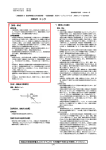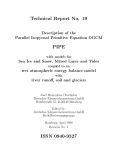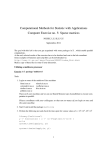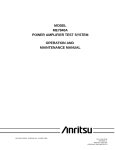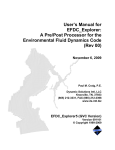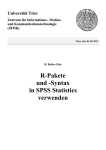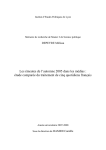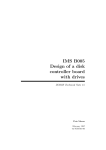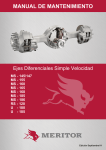Download APPENDIX B1
Transcript
APPENDIX B1
HYDRODYNAMIC MODEL
TRAINING MANUAL
OTB INTEGRATED MODEL
SYSTEM
HYDRODYNAMIC MODEL
MODEL CALIBRATION MANUAL
INTRODUCTION
This training manual has been prepared to support the calibration components for the
Hydrodynamic Model of the OTB Integrated Model System. The objectives of this training
manual is as follows;
Provide instruction to users on the HYDRODYNAMIC MODEL structure and how to setup and run the model for the OTB Integrated Model System
Provide tools/instruction to allow users to produce graphics and statistics using the
model calibration graphics and statistics as an example
Based upon these objectives, this manual provides specific descriptions and instructions for the
OTB specific Hydrodynamic Model application, and is not meant as a general user’s manual.
The model manual has been provided with the model files and provides more general
instruction on the capabilities and options available. Additionally, this manual provides
instructions on how to post-process the output to generate the graphics and statistics from the
model calibration report. Instruction on post-processing for assessment of alternate model
scenarios will be provided in future training sessions.
The instructions are presented in three primary steps, these are;
Step 1: Setting up the Hydrodynamic Model control and input files
Step 2: Running the Hydrodynamic Model
Step 3: Hydrodynamic Model post-processing for calibration graphics and statistics
STEP 1: SETTING UP THE HYDRODYNAMIC MODEL CONTROL AND
INPUT FILES
In order to run the Hydrodynamic Model application for the Integrated OTB model system, four
files are needed. These are;
run_data: the primary input file for the Hydrodynamic Model; includes the model run
control, model coefficients, model output control, and boundary conditions
model_grid: contains the grid geometry data, the depths, the specification of the vertical
layers, and the specification of the thin wall dams
groundwater.map: provides information on zoneation of the model grid for the purpose
of defining groundwater inflows spatially
ecom3d.exe: the executable file for the Hydrodynamic Model (for this version)
The time dependant boundary conditions included in the run_data file are generated from time
series data stored within ACCESS databases provided with the model input files. Figure 1
below provides a schematic representation of the ACCESS database structure, the specific data
sets that feed into the 6 ACCESS database files that contain the boundary condition
information, and the flow of data from the 6 ACCESS databases to the run_data file.
The specific ACCESS database files which contain the data for each of the boundary conditions
listed above are provided within the blue circles in Figure 1. Additionally, the specific data input
(blue box) and the individual file names for each input (green boxes) are shown. For each of
the six boundary conditions a single ACCESS database file is created which merges all of the
data within the circle. The final output files are shown attached to the circle feeding into the
run_data file. The 6 ACCESS files are as follows;
ELEVATION.accdb: Time series of water levels applied uniformly to the Hydrodynamic
Model offshore boundary.
SALTEMP.accdb: Time series of salinity and temperature applied uniformly to the OTB
hydrodynamic model grid offshore cells.
RIVERFLOW.accdb: Time series of tributary inflows and temperatures input at specific
model grid locations.
DIRECTPS.accdb: Time series of direct point source inflows and temperatures input at
specific model grid locations
GROUNDWATER.accdb: Constant groundwater inflows and temperatures applied
throughout the OTB hydrodynamic model
MET.accdb: Time series of meteorologic data applied throughout the OTB
hydrodynamic model
Figure 1: Hydrodynamic Model Input File Structure
The following provides detailed descriptions of all of the variables within the three model input
files. Additionally, detailed instructions are provided for creation of the boundary conditions in
the run_data file from the ACCESS databases.
run_data
run_data
file:
The run_data file is broken down into 8 separate Data Groups. Appendix A presents a detailed
discussion of the variables, options, and input formats for each of the Data Groups. The
specific Data Groups include;
Data Group A – Computational and Diagnostic Characteristics
Data Group B – Hydrodynamic Characteristics (coefficients)
Data Group C – Result Evaluation (Output)
Data Group D – Standard Level Declaration
Data Group E – Initial Temperature and Salinity
Data Group F – Open Boundary Conditions
Data Group G – Inflow Boundary Conditions
Data Group H – Meteorologic Boundary Conditions
Under Data Group F, two sub-groups of open boundary forcing data exist, these are
Sub-data Group F1 - water surface elevation data
Sub-data Group F2 - salinity and temperature data
Under Data Group G, three sub-groups exists, these are;
Sub-data Group G1 – tributary inflows and temperatures
Sub-data Group G2 – direct point source discharges and temperatures
Sub-data Group G3 – groundwater inflows and temperatures by zone (based on
groundwater.map file)
The following outlines the steps for creation of each of the sub-groups. The USER is referred to
Appendix A for details on the specific formats for each group.
Step 1-1: Define the model controls and the type of model to run using the variables in data
group A. This includes;
1.
2.
3.
4.
Run options
Run computational characteristics (time step, etc)
Run output characteristics
Run print characteristics
Step 1-2: Define the model coefficients using the variables in data group B. This includes;
1. Model coefficients
2. Horizontal mixing coefficients
3. Vertical mixing coefficients
Step 1-3: Define the model output using the variables in data group C. This includes;
1.
2.
3.
4.
5.
Model output control for GCMPLT file
Output interval for time series in GCMTSR file
Model grids for elevation time series into GCMTSR
Model grids for velocity, salinity and temperature time series in GCMTSR
Model grids and directions for flux output to GCMTSR
6. Model output control for GCM_TRAN file to water quality model
Step 1-4: Define the vertical depth levels for calculation of the density gradients that feed into
the Hydrodynamic Model (Standard Level Declaration) for data group D.
1. Number of vertical layers
2. Fixed depths for each layer
Step 1-5: Define the fixed salinity and temperature initial conditions by Standard Level for data
group E.
1. Input fixed initial temperature for each layer
2. Input fixed initial salinity for each layer
Step 1-6: Input the water surface elevation forcing function for data group F1
1. Define the number of cells over which the water surface elevation forcing is applied
2. Define the grids and the connecting grids (I,J) for the water surface elevation forcing
3. Input the time series data for each defined grid as block data using the ACCESS
database “ELEVATION.accdb”
a. This database contains one primary data table, “Elevation_BC”, which includes
time and elevation data at 6-minute intervals
b. Export four BC files
i. ELEVATIONBC1.xls” - Hour 0 - 24999.976
ii. ELEVATIONBC2.xls” - Hour 25000.076 - 49999.976
iii. ELEVATIONBC3.xls” - Hour 50000.076 - 74999.976
iv. ELEVATIONBC4.xls” - Hour 75000.076 - 96430.176
c. Remove header row (Row 1) from each file
d. Set format to 5 decimals
e. Set column width to 11
f. Save as: “ELEVATIONBC1.prn”, “ELEVATIONBC2.prn”,
“ELEVATIONBC3.prn”, “ELEVATIONBC4.prn
g. Run executable: “elevationbc.exe”
h. Creates formatted file for putting into “run_data”: “ELEVATIONBC”
Step 1-7: Input the salinity and temperature forcing function for data group F2
1. Input the time series data for each defined grid as block data using the ACCESS
database “SALTEMP.accdb”
a. This database contains one primary data table, “SalTemp”, which includes
monthly water column EPCHC salinity and temperature data at Station 94.
b. Final ACCESS table: “SALTEMPBC”
c. Export to: “SALTEMPBC.xls”
i. Remove header row (Row 1)
ii. Set format to 1 decimal
iii. Set column width to 8
d. Save as: “SALTEMPBC.prn”
e. Run executable “SALTEMPBC.exe”
f. Creates formatted file for putting into “run_data”: “SALTEMPBC”
Step 1-8: Input the river inflows and temperatures for data group G1
1. Define the number of river inflows
2. Define the grids, the connecting grids (I,J), and the vertical distribution of the flows for
the river inflows
3. Input the time series data for flow, temperature, and salinity for each defined grid as
block data using the ACCESS database “RIVERFLOW.accdb”
a. This database contains seven primary data tables:
i. “Flows_1999” and “Flows_2000_2009” contain daily INTB flows by
reach, including all reaches used to develop port flows
ii. “MR_TCB_flows” contains monthly flows for Manatee River and Terra
Ceia Bay, outside the INTB domain, from TBEP data
iii. “Lake_Tarpon_flows” contains daily observed flows for Lake Tarpon
iv. “HR_TBC_flows” contains daily observed flows for Hillsborough River
Dam and Tampa Bypass Canal S-160
v. “Stream_Temp” contains daily stream temperatures based on monthly
observed data for each inflow location
b. Final ACCESS table: “RIVERFLOW”
c. Export to: “RIVERFLOWS.xls”
i. Remove header row (Row 1)
ii. Set format to 5 decimals
iii. Set column width to 11
d. Save as: “RIVERFLOW.prn”
e. Run executable: “RIVERFLOW.exe”
f. Create formatted file for putting into “run_data”: “RIVERFLOW”
Step 1-9: Input the point source discharges for data group G2
1. Define the number of point source discharges
2. Define the grids and the distribution of the flows over the vertical
3. Input the time series data for each point source flow, temperature, and salinity by
defined grid as block data using the ACCESS database “DIRECTPS.accdb”
a. This database contains one primary data table, “Direct_PS_flows”, which
includes monthly discharges directly to Tampa Bay from Howard F. Curren
and the City of Clearwater North and Northeast facilities.
b. Final Access table: “DIRECTPS”
c. Export to: “DIRECTPS.xls”
i. remove header row (Row 1),
ii. set format to 5 decimals,
iii. set column width to 11 in Excel file
d. Save as : “DIRECTPS.prn”
e. Run executable: “DIRECTPS.exe”
f. Creates formatted file for putting into “run_data”: “DIRECTPS”
Step 1-10: Input the groundwater inflows for data group G3
1. Define the number of zones in the groundwater.map
2. Input the time series data for each zone including flow, temperature, and salinity using
the ACCESS database “GROUNDWATER.accdb”
a. This database contains one primary data table, “GW_flows”, which includes
the time-invariant inflows to 5 bay regions.
b. Final Access table: “GW”
c. Export to: “GW.xls”
i. remove header row (Row 1),
ii. remove column B
iii. set format to 6 decimals,
iv. set column width to 10 in Excel file
d. Convert to: “GW.prn”
e. Run executable: “GW.exe”
f. Creates formatted file for putting into “run_data”: “GW”
Step 1-11: Input the meteorology data for data group H
1. Define the type of met data inputs and basic meteorologic parameters
2. Input the time series data for each zone including wind speed, wind direction, shortwave radiation, air temperature, relative humidity, barometric pressure, cloud cover,
light extinction coefficient, precipitation, evaporation using the ACCESS database
“MET.accdb”
a. This database contains four primary data tables:
i. “DoverET” contains daily ET rates (in/day)
ii. “Rainfall” contains daily segment-specific rainfall (in/day) derived from
TBEP rainfall estimates
iii. “OTB_Secchi” contains monthly OTB average Secchi disk depth (m)
from EPCHC data
iv. “SP CLW MET DATA" contains hourly St. Petersburg/Clearwater
Airport wind speed, wind direction, air temperature, atmospheric
pressure, cloud cover, Dover solar radiation, and Dover relative
humidity
b. Final Access table: “MET”
c. Export to: “MET.xls”
i. Remove header row (Row 1)
ii. Set format to 5 decimals
iii. Set column width to 11
d. Save as: “MET.prn”
e. Run executable: “MET.exe”
f. Creates formatted file for putting into “run_data”: “MET”
model_grid
run_data
file:
The OTB model_grid file has three primary sections, these are;
Specification of the Sigma Levels
Horizontal Grid Data
Specification of the Locations of Thin Wall Dams
Appendix B presents detailed descriptions of the variables within the model_grid file and the
input formats.
groundwater.map
The OTB groundwater.map file defines what grid cells are located within 5 different zones within
the model grid domain. A total of 5 zones are defined, and the groundwater.map file simply
provides for the I,J grid numbers and what zone (1 to 5) that cell resides in. Within the run_data
file, in Section G under the Diffuser-GW the constant flow values, for each of the 5 segments,
are read in at time 0.0 and the same value for time 99999.0 which sets these values to the
constants for the full simulation.
STEP 2: RUNNING THE MODEL
Prior to running the OTB Hydrodynamic Model, it is recommended that the user set up a base
directory for the runs, an example might be as follows:
OTBhydro>baserun
Under the baserun sub-directory set up two directories, model_input, model_output. Put the
three model inputs (run_data, model_grid, and groundwater.map), the model executable
(ecom3d33.exe), and the batch file (discussed below) in the model_input directory.
Subsequent runs could then be identified by other names (i.e. baserun_1) and set up under
their own sub-directory.
A batch file <file>.bat is set up in the same directory as the executable and the model input files.
The batch file has the structure as shown below.
set ncpus=4
set OMP_NUM_THREADS=4
ecom3d33.exe
pause
The first two lines of code in the batch file are common methods for setting the number of
threads on the computer being utilized. The specification of the number if threads is critically
important to model run time.
A command line window will then appear. The window will provide a count on the number of
days the model has run. JHIST=<number> provides the count by days that the model has run.
The number of processors in the computer running the model its processor speed and other
factors will define how long the model will run.
STEP 3: MODEL POST PROCESSING FOR CALIBRATION GRAPHICS
AND STATISTICS
Figure 2 provides a flow chart showing the output file structure from ECOMSED and what each
will be utilized for. ECOMSED outputs 4 primary files for use in post-processing data. These
are;
GCMTSR
GCM_TRAN
GCM_GEOM
GCMPLT
Wave.out
The GCMTSR file provides high temporal resolution time series results at specified grid cells
based upon the control variables defined in Data Group C. In data group C specific cells for the
GCMTSR output are specified for elevations as a group; currents, temperature and salinity as a
group; and fluxes as a group. The GCM_TRAN and GCM_GEOM files provide the
hydrodynamic input to the RCA water quality model. The GCMPLT file provides output for the
full grid for all variables at specified intervals. The Wave.out file contains the time series of
information from the wave model. For the purposes of the calibration manual, only the GCMTSR
and Wave.out results are discussed.
Figure 2: Hydrodynamic Output File Structure
Post-Processing GCMTSR to create .txt time series files
A program has been provided with the model run files called tsrdat.exe. This program reads the
GCMTSR binary file and creates a series of .txt files. The .txt files each then correspond to
associated data files that are used for comparison of the model results to the data files. The .txt
data files and the .txt output files from the model base run are provided on the hard drive
included with the presentation.
Tables 1 through 4 below show the one-to-one correspondence of the .txt files from the model
with the .txt files from the data. When the tsrdat.exe program is run two files are created, these
are HeaderData.txt and tsrhdr.txt. These files provide the structure and order of the data within
the post-processed model files.
Post-Processing Wave.out to create .txt time series files
A program has been provided with the model run files called Waveread.exe. This program
reads the Wave.out file and creates a series of .txt files for the various output stations identified.
The .txt files each then correspond to time series output from the wave component of the
hydrodynamic model. The specific variables output in order following the time and I,J locations
include;
Wave Height
Wave Period
Wave Direction
Bottom Shear Stress
As there is not direct data for comparison of the wave model results, only the model output files
are discussed herein.
Table 1 – Correspondence of data .txt files with model .txt files for water surface elevation
Water Level
DATA
Model Output
OPTs.txt
elvpts.txt
MKBs.txt
elvpts.txt
SPs.txt
elvpts.txt
PMs.txt
elvpts.txt
tarponcanal.txt
elvpts.txt
Table 2 – Correspondence of data .txt files with model .txt files for currents
Currents
DATA
OPT_CU_TS.txt
WI_CU_3TS.txt
SS_CU_TS.txt
Model Output
velpt2.txt
velpt3.txt
velpt1.txt
Table 3 – Correspondence of data .txt files with model .txt files for salinity and temperature
Salinity and Temperature
DATA
Model Output
epc14.txt
velpt27.txt
epc23.txt
velpt37.txt
epc16.txt
velpt28.txt
epc33.txt
velpt32.txt
epc42.txt
velpt11.txt
epc47.txt
velpt12.txt
epc60.txt
velpt16.txt
epc62.txt
velpt17.txt
epc70.txt
velpt56.txt
epc44.txt
velpt53.txt
epc64.txt
velpt19.txt
epc8.txt
velpt52.txt
epc6.txt
velpt50.txt
epc7.txt
velpt51.txt
epc9.txt
velpt24.txt
epc11.txt
velpt25.txt
epc13.txt
velpt26.txt
epc19.txt
velpt29.txt
epc21.txt
velpt36.txt
epc24.txt
velpt38.txt
epc25.txt
velpt39.txt
epc28.txt
velpt30.txt
epc32.txt
velpt31.txt
epc36.txt
velpt7.txt
epc38.txt
velpt8.txt
epc40.txt
velpt9.txt
epc41.txt
velpt10.txt
epc50.txt
velpt14.txt
epc51.txt
velpt15.txt
epc52.txt
velpt54.txt
epc55.txt
velpt55.txt
epc61.txt
velpt13.txt
epc63.txt
velpt18.txt
epc65.txt
velpt20.txt
epc66.txt
velpt21.txt
epc67.txt
velpt22.txt
epc68.txt
velpt23.txt
epc71.txt
velpt57.txt
epc73.txt
velpt58.txt
epc80.txt
velpt60.txt
epc81.txt
velpt33.txt
epc82.txt
velpt34.txt
epc84.txt
velpt35.txt
epc90.txt
velpt40.txt
epc91.txt
velpt41.txt
epc92.txt
velpt42.txt
epc93.txt
velpt43.txt
epc94.txt
velpt44.txt
epc95.txt
velpt45.txt
epc96.txt
velpt46.txt
Table 4 – Correspondence of data .txt files with model .txt files for flux through CCC
Flux
DATA
East032312.txt
West032312.txt
East041712.txt
West041712.txt
Model Output
flxpts.txt
flxpts.txt
flxpts.txt
flxpts.txt
R-CODE FOR POST PROCESSING
epc47example.R
Code for recreating hydrodynamic calibration figures in R
R Manual for Hydrodynamic Model Calibration:
Objective: Create hydrodynamic calibration figures and statistics using an open resource data analysis package. Below is an example of how to
import data, get data ready for use, and create figures using ggplot2 in R.
General information: R stores functions as libraries. We will be using the library ggplot2 for all of the graphics. The first time you use ggplot2 you
must download the library: 1) select the cran mirror (choose USA(CA2), and then select install package(S),choose ggplot2, all of this is under the
Packages drop down menu, afterwards you then need to tell R to open the library by using the following command. library(ggplot2)
Data Import:
The primary functions to read data into R are read.table (for text files) and read.csv (for csv files). To read in a data file 1) name the file (if you do
not name the file then R will open up the data in the workspace), 2) tell R what function to use (read.table or read.csv), 3) tell R where the file is,
4) how the data are separated, 5) and if there are column names (header).
Note: R is case sensitive
A skeleton example
x<-read.table("C:/tmpR/example.txt",sep="",header=FALSE)
Since the file was named the file is now stored in R
read.table("C:/tmpR/example.txt",sep="",header=FALSE)
1
2
3
4
V1 V2
1 4
2 6
5 8
10 10
The above command was not named, therefore, the file will appear in the workspace
Note: R is case sensitive
Below is the code used to reproduce the EPC 47 surface salinity figure (Figure 3-44) from the hydrodynamic calibration report
Data files used: model output file = velpt12.txt, observed data file = epc47.txt
Both files are text files, separated with spaces, and no header
Code to read the model output file velpt12.txt, this will take a few minutes due to the size of the file
velpt12<-read.table("C:/Users/john/Documents/Calibration Report
FINAL/velpt12.txt",sep="",header=FALSE)
Can use command head to verify the file was read in correctly head(velpt12)
1
2
3
4
5
6
V1 V2
0.00208
6
0.00625
6
0.01042
6
0.01458
6
0.01875
6
0.02292
6
V3 V4 V5
1.59
0 0
1.91
0 0
1.91
0 0
1.91
0 0
1.91
0 0
1.91
0 0
V6
21.11
25.33
25.33
25.33
25.33
25.33
V7 V8 V9
0 0
13.76
0 0
16.51
16.51
0 0
16.51
0 0
16.51
0 0
16.51
0 0
file:///E|/epc47example.html[11/15/2013 10:20:46 AM]
V10
21.11
25.33
25.33
25.33
25.33
25.33
V11 V12 V13
13.76
0
16.51
0
16.51
0
16.51
0
16.51
0
16.51
0
0
0
0
0
0
0
V14
21.11
25.33
25.33
25.33
25.33
25.33
V15
13.76
16.51
16.51
16.51
16.51
16.51
epc47example.R
1
2
3
4
5
6
V16 V17
0
0
0
0
0
0
0
0
0
0
0
0
V18
21.11
25.33
25.33
25.33
25.33
25.33
V19 V20 V21
13.76
0
16.51
0
16.51
0
16.51
0
16.51
0
16.51
0
V22
21.11
25.33
25.33
25.33
25.33
25.33
0
0
0
0
0
0
V23
13.76
16.51
16.51
16.51
16.51
16.51
Can use the command dim to verify all rows and columns were read correctly dim(velpt12)
[1] 963600
23
Code to read the observed data file epc47.txt
epc47<-read.table("C:/Users/john/Documents/Calibration Report FINAL/epc47.txt",sep = "",header=FALSE)
Verify the data were read in correctly head(epc47)
1
2
3
4
5
6
V1
18.6
13.9
20.9
24.2
24.1
29.0
V2
18.7
13.7
21.4
24.2
24.2
29.1
V3
19.1
13.8
22.2
24.2
24.3
29.1
V4
26.0
27.3
27.5
28.5
30.4
32.0
V5
26.0
25.8
27.3
28.5
30.3
32.0
V6
25.8
25.6
27.0
28.5
30.2
31.9
V7
8843
9515
10211
11027
11699
12539
dim(epc47) [1]
120
7
Add a header to each file
Create a vector of the names, for example: names<-c("a","b")
Vector of names for velpt12
namesvelpt<-c("Time","k","dz","u1","v2","s1","t1","u2","v2","s2","t2","u3","v3","s3","t3","u4",
"v4","s4","u5","v5","s5","t5")
Use the function colnames to add the vector of column headers created above colnames(velpt12)<-namesvelpt
Verify by using the head command head(velpt12)
1
2
3
4
5
6
1
2
3
4
5
6
Time k
0.00208
0.00625
0.01042
0.01458
0.01875
0.02292
v4
s4
0 21.11
0 25.33
0 25.33
0 25.33
0 25.33
0 25.33
6
6
6
6
6
6
dz u1 v2
1.59
0
1.91
0
1.91
0
1.91
0
1.91
0
1.91
0
t4 u5 v5
13.76
0
16.51
0
16.51
0
16.51
0
16.51
0
16.51
0
0
0
0
0
0
0
0
0
0
0
0
0
s1
21.11
25.33
25.33
25.33
25.33
25.33
s5
21.11
25.33
25.33
25.33
25.33
25.33
t1 u2 v2
13.76
0
16.51
0
16.51
0
16.51
0
16.51
0
16.51
0
t5
13.76
16.51
16.51
16.51
16.51
16.51
file:///E|/epc47example.html[11/15/2013 10:20:46 AM]
0
0
0
0
0
0
s2
21.11
25.33
25.33
25.33
25.33
25.33
t2 u3 v3
13.76
0
16.51
0
16.51
0
0
16.51
0
16.51
0
16.51
0
0
0
0
0
0
s3
21.11
25.33
25.33
25.33
25.33
25.33
t3 u4
13.76
16.51
16.51
16.51
16.51
16.51
0
0
0
0
0
0
epc47example.R
Repeat the above steps to add column names to the epc47 dataset namesepc<c("TB","TM","TS","SB","SM","SS","Year")
key: TB=temperature bottom, TM=temperature middle, TS = temperature surface, SB=salinity bottom, SM = salinity middle, SS = salinity surface,
Year = time variable
colnames(epc47)<-namesepc
head(epc47)
1
2
3
4
5
6
TB
18.6
13.9
20.9
24.2
24.1
29.0
TM
18.7
13.7
21.4
24.2
24.2
29.1
TS
19.1
13.8
22.2
24.2
24.3
29.1
SB
26.0
27.3
27.5
28.5
30.4
32.0
SM
26.0
25.8
27.3
28.5
30.3
32.0
SS
25.8
25.6
27.0
28.5
30.2
31.9
Year
8843
9515
10211
11027
11699
12539
For plotting purposes need to standardize the time variable in both datasets
Create new vector that includes the time variable from velptxx + 730121 and add it to the velpt12 dataset
velpt12$Time_stand<-(velpt12$Time + 730121)
Use command head to verify column was added head(velpt12)
1
2
3
4
5
6
1
2
3
4
5
6
Time k
dz u1 v2
0.00208
6 1.59
0 0
0.00625
6 1.91
0 0
0.01042
6 1.91
0 0
0.01458
6 1.91
0 0
0.01875
6 1.91
0 0
0.02292
6 1.91
0 0
v4
s4
t4 u5 v5
0 21.11 13.76
0 0
0 25.33 16.51
0 0
0 25.33 16.51
0 0
0 25.33 16.51
0 0
0 25.33 16.51
0 0
0 25.33 16.51
0 0
s1
21.11
25.33
25.33
25.33
25.33
25.33
s5
21.11
25.33
25.33
25.33
25.33
25.33
t1 u2 v2
s2
13.76
0 0 21.11
16.51
0 0 25.33
16.51
0 0 25.33
16.51
0 0 25.33
16.51
0 0 25.33
16.51
0 0 25.33
t5 Time stand
13.76
730121
16.51
730121
16.51
730121
16.51
730121
16.51
730121
16.51
730121
t2 u3 v3
0
13.76
16.51
0
16.51
0
0
16.51
0
16.51
0
16.51
0
0
0
0
0
0
s3
21.11
25.33
25.33
25.33
25.33
25.33
Repeat the steps for the epcxx data epc47$Time_stand<((epc47$Year/24)+730121)
head(epc47)
1
2
3
4
5
6
TB
18.6
13.9
20.9
24.2
24.1
29.0
TM
18.7
13.7
21.4
24.2
24.2
29.1
TS
19.1
13.8
22.2
24.2
24.3
29.1
SB
26.0
27.3
27.5
28.5
30.4
32.0
SM
26.0
25.8
27.3
28.5
30.3
32.0
SS
25.8
25.6
27.0
28.5
30.2
31.9
Year Time stand
8843
730489
9515
730517
10211
730546
11027
730580
11699
730608
12539
730643
The velpt12 dataset included data from 1999 so need to subset the data to only included data from
2000 to 2009, use the function subset to do this
velpt12_date_2000<-subset(velpt12,Time_stand>=730486)
file:///E|/epc47example.html[11/15/2013 10:20:46 AM]
t3 u4
13.76
16.51
16.51
16.51
16.51
16.51
0
0
0
0
0
0
epc47example.R
You now have a new dataset called velpt12_data_2000 that was created from velpt12 and included all data from 2000 to 2009
The data are ready to create the figure from the hydrodynamic calibration report
Note: verify you opened up the library ggplot2 from the above steps if not do it now library(ggplot2)
Skelton of the ggplot2 function,
name.plot<-ggplot(name of data set, aes(xaxis=what column,yaxis=what column)) + geom_line (or geom_point etc., this command specifys
what kind of plot wanted) + scale_x_continuous(breaks=c())use this command if you want specific breaks in the x axis,
continuous_scale(aesthetics = c("x", "xmin", "xmax", "xend", "xintercept"), scale_name = "position_c", palette = identity, breaks = ..1, expand
= expand, guide = "none")
Naming the plot allows you to add additional layers
Note: the plot will not appear in the R window when named unless you specifically tell R to open it
First layer, velpt12_date_2000 as a line
velpt12SS<-ggplot(velpt12_date_2000, aes(x=Time_stand, y=s1,colour="Model Station")) +
geom_line(shape="line")
See plot in R
velpt12SS
file:///E|/epc47example.html[11/15/2013 10:20:46 AM]
epc47example.R
Add the observed epc47 data as points he observed EPC data as a point plot (note: when adding a second layer, need to specify data outside of the
aes line), shape, size, and color
epc47_SS<-velpt12SS + geom_point(aes(x=Time_stand, y=SS, shape="EPC47
Data"),data=epc47,size=3,colour="black")
The above plot now as both layers, velpt12SS and epc47_SS
epc47_SS
file:///E|/epc47example.html[11/15/2013 10:20:46 AM]
epc47example.R
Specify the theme for the plot, this theme removes the default gray background and adds the location of the legend
epc47_SS_theme<-epc47_SS + theme(legend.title=element_blank())+ theme(legend.justification=c(1,1), legend.position=c(1,1))+
theme(panel.border=element_rect(colour="black", fill=NA))+
theme(axis.text = element_text(colour = "black", size = 12))+
theme(panel.background = element_rect(fill = NA, colour = "black"))+
theme(legend.key=element_rect(fill=NA))
Can see the difference
epc47_SS_theme
file:///E|/epc47example.html[11/15/2013 10:20:46 AM]
epc47example.R
Add the x and y labels
epc47_SS_axis<-epc47_SS_theme + scale_x_continuous(breaks=c(730486.00, 730852.00, 731217.00,
731582.00, 731947.00, 732313.00, 732678.00, 733043.00,
733408.00,733774.00), labels=c(2000,2001,2002,2003,2004,2005,2006,2007,2008,2009))+
ylim(0,40)+ xlab("Year") +ylab("Salinity (ppt)")
What the figure now looks like epc47_SS_axis
file:///E|/epc47example.html[11/15/2013 10:20:46 AM]
epc47example.R
Add title
epc47_SS_title<-epc47_SS_axis + ggtitle("EPC47 Surface Salinity")
epc47_SS_title
file:///E|/epc47example.html[11/15/2013 10:20:46 AM]
epc47example.R
Change the color of the lines and style of the circles
epc47_SS_final<-epc47_SS_title + scale_colour_manual(values=c("dodgerblue4"))+
scale_shape_manual(values=1)
The figure is now ready
epc47_SS_final
file:///E|/epc47example.html[11/15/2013 10:20:46 AM]
epc47example.R
Save the plot as a pdf on the computer using the function ggsave, base code (name of figure, where you want it saved and the name you want the graph
to be called, size)
ggsave(epc47_SS_final, filename="C:/Users/john/Documents/old tampa
bay/EPC_Plots/EPC47SurfaceSalinity.pdf",height=7.5,width=7.5)
file:///E|/epc47example.html[11/15/2013 10:20:46 AM]
Statistics and Calculations.R
Code for recreating hydrodynamic calibration figures in R
Old Tampa Bay Project
Hydrodynamic Output, R code for statistics
EPC statistics, sample EPC47, data used: model output=velpt12.txt, observed data = epc47.txt
See manual on R figures for details about libraries and reading and formatting data in R
See files: epc_stats_Rcode.R, CU_stats.R, TandSBCstats.R, WL_stats_Rcode.R for code for all statistics in the
hydrodynamic calibration report
velpt12<-read.table("C:/Users/john/Documents/Calibration Report FINAL/velpt12.txt",sep="",header=FALSE)
epc47<-read.table("C:/Users/john/Documents/Calibration Report FINAL/epc47.txt",sep = "",header=FALSE)
Add colnames
namesvelpt<-c("Time","k","dz","u1","v2","s1","t1","u2","v2","s2","t2","u3","v3","s3","t3","u4","v4","s4","t4",
"u5","v5","s5","t5")
colnames(velpt12)<-namesvelpt
namesepc<-c("TB","TM","TS","SB","SM","SS","Year")
colnames(epc47)<-namesepc
Standardize epc date
epc47$Time_stand<-(epc47$Year/24)
Interpolation surface salinity
Need to install library signal and then code in R for the library to open
library(signal)
Loading required package: MASS
Attaching package: 'signal'
The following objects are masked from 'package:stats':
filter, poly
Interpolate salinity values at match time stamp values to the observed data using the function interp1
EPC47_SS<-data.frame(actual=interp1(velpt12$Time,velpt12$s1,epc47$Time_stand,'linear'))
Create a new data set with the interpolated salinity values and observed salinity values
EPC47_SS2 <- data.frame(interp=EPC47_SS[,1], actual=epc47$SS)
Statistics to compare between salinity values
Linear model between the interpolated and observed (actual) values
EPC47_SS.lm <- lm(interp~actual,
data=EPC47_SS2);summary(EPC47_SS.lm )
Call:
lm(formula = interp ~ actual, data = EPC47_SS2)
Residuals:
Min
1Q Median
-2.674 -0.720 -0.091
3Q
0.858
Max
3.315
Coefficients:
Estimate Std. Error t value Pr(>|t|)
(Intercept)
3.1965
0.6363
5.02 1.8e-06 ***
actual
0.8891
0.0253
35.20 < 2e-16 ***
--Signif. codes: 0 '***' 0.001 '**' 0.01 '*' 0.05 '.' 0.1 ' ' 1
Residual standard error: 1.25 on 118 degrees of freedom
Multiple R-squared: 0.913, Adjusted R-squared: 0.912
F-statistic: 1.24e+03 on 1 and 118 DF, p-value: <2e-16
Calculate error between the interpolated and observed (actual) values
EPC47_SS.error <- EPC47_SS2$actual-EPC47_SS2$interp
Functions to calculate RMSE,MAE and ME
RMSE <- function(EPC47_SS.error){
sqrt(mean(EPC47_SS.error^2))
}
mae <- function(EPC47_SS.error){
file:///E|/stats%20and%20calculations.html[11/15/2013 2:09:40 PM]
Statistics and Calculations.R
mean(abs(EPC47_SS.error))
}
me <- function(EPC47_SS.error){
mean(EPC47_SS2$actual-EPC47_SS2$interp)
}
Use the above functions to calculate the statistics
RMSE_EPC47_SS <- RMSE(EPC47_SS.error)
Round value
RMSE_EPC47_SS_round<-lapply(RMSE_EPC47_SS,round,1);RMSE_EPC47_SS_round
[[1]]
[1] 1.4
MAE_EPC47_SS <- mae(EPC47_SS.error)
MAE_EPC47_SS_round<-lapply(MAE_EPC47_SS,round,1);MAE_EPC47_SS_round
[[1]]
[1] 1.1
ME_EPC47_SS <- me(EPC47_SS.error)
ME_EPC47_SS_round<-lapply(ME_EPC47_SS,round,1);ME_EPC47_SS_round
[[1]]
[1] -0.4
R2_EPC47_SS<- summary(EPC47_SS.lm)$r.squared
R2_EPC47_SS_round<-lapply(R2_EPC47_SS,round,2);R2_EPC47_SS_round
[[1]]
[1] 0.91
N <- length(EPC47_SS2[,1]);N
[1] 120
Repeat above code for bottom salinity, change to appropriate columns
EPC47_SB<-data.frame(actual=interp1(velpt12$Time,velpt12$s5,epc47$Time_stand,'linear'))
EPC47_SB2 <- data.frame(interp=EPC47_SB[,1], actual=epc47$SB)
Linear model
EPC47_SB.lm <- lm(interp~actual,
data=EPC47_SB2);summary(EPC47_SB.lm )
Call:
lm(formula = interp ~ actual, data = EPC47_SB2)
Residuals:
Min
1Q Median
-2.594 -0.721 -0.126
3Q
0.974
Max
2.787
Coefficients:
Estimate Std. Error t value Pr(>|t|)
(Intercept)
2.4199
0.6198
3.9 0.00016 ***
actual
0.9066
0.0241
37.6 < 2e-16 ***
--Signif. codes: 0 '***' 0.001 '**' 0.01 '*' 0.05 '.' 0.1 ' ' 1
Residual standard error: 1.14 on 118 degrees of freedom
Multiple R-squared: 0.923, Adjusted R-squared: 0.922
F-statistic: 1.41e+03 on 1 and 118 DF, p-value: <2e-16
Error
EPC47_SB.error
<- EPC47_SB2$actual-EPC47_SB2$interp
RMSE,MAE and ME functions
RMSE <- function(EPC47_SB.error){
sqrt(mean(EPC47_SB.error^2))
}
mae <- function(EPC47_SB.error){
file:///E|/stats%20and%20calculations.html[11/15/2013 2:09:40 PM]
Statistics and Calculations.R
mean(abs(EPC47_SB.error))
}
me <- function(EPC47_SB.error){
mean(EPC47_SB2$actual-EPC47_SB2$interp)
}
Statistics
RMSE_EPC47_SB <- RMSE(EPC47_SB.error)
RMSE_EPC47_SB_round<-lapply(RMSE_EPC47_SB,round,1);RMSE_EPC47_SB_round
[[1]]
[1] 1.2
MAE_EPC47_SB <- mae(EPC47_SB.error)
MAE_EPC47_SB_round<-lapply(MAE_EPC47_SB,round,1);MAE_EPC47_SB_round
[[1]]
[1] 1
ME_EPC47_SB <- me(EPC47_SB.error)
ME_EPC47_SB_round<-lapply(ME_EPC47_SB,round,1);ME_EPC47_SB_round
[[1]]
[1] -0.1
R2_EPC47_SB<- summary(EPC47_SB.lm)$r.squared
R2_EPC47_SB_round<-lapply(R2_EPC47_SB,round,2);R2_EPC47_SB_round
[[1]]
[1] 0.92
N <- length(EPC47_SB2[,1]);N
[1] 120
Repeat above code for surface temperature, change to appropriate columns
EPC47_TS<-data.frame(actual=interp1(velpt12$Time,velpt12$t1,epc47$Time_stand,'linear'))
EPC47_TS2 <- data.frame(interp=EPC47_TS[,1], actual=epc47$TS)
Linear model
EPC47_TS.lm <- lm(interp~actual,
data=EPC47_TS2);summary(EPC47_TS.lm )
Call:
lm(formula = interp ~ actual, data = EPC47_TS2)
Residuals:
Min
1Q Median
-3.928 -0.519 0.076
3Q
0.592
Max
2.070
Coefficients:
Estimate Std. Error t value Pr(>|t|)
(Intercept)
-0.2719
0.3725
-0.73
0.47
actual
0.9621
0.0153
63.00
<2e-16 ***
--Signif. codes: 0 '***' 0.001 '**' 0.01 '*' 0.05 '.' 0.1 ' ' 1
Residual standard error: 0.912 on 118 degrees of freedom
Multiple R-squared: 0.971, Adjusted R-squared: 0.971
F-statistic: 3.97e+03 on 1 and 118 DF, p-value: <2e-16
Error
EPC47_TS.error <- EPC47_TS2$actual-EPC47_TS2$interp
RMSE,MAE and ME functions
RMSE <- function(EPC47_TS.error){
sqrt(mean(EPC47_TS.error^2))
}
mae <- function(EPC47_TS.error){
mean(abs(EPC47_TS.error))
}
me <- function(EPC47_TS.error){
mean(EPC47_TS2$actual-EPC47_TS2$interp)
}
file:///E|/stats%20and%20calculations.html[11/15/2013 2:09:40 PM]
Statistics and Calculations.R
Statistics
RMSE_EPC47_TS <- RMSE(EPC47_TS.error)
RMSE_EPC47_TS_round<-lapply(RMSE_EPC47_TS,round,1);RMSE_EPC47_TS_round
[[1]]
[1] 1.5
MAE_EPC47_TS <- mae(EPC47_TS.error)
MAE_EPC47_TS_round<-lapply(MAE_EPC47_TS,round,1);MAE_EPC47_TS_round
[[1]]
[1] 1.3
ME_EPC47_TS <- me(EPC47_TS.error)
ME_EPC47_TS_round<-lapply(ME_EPC47_TS,round,1);ME_EPC47_TS_round
[[1]]
[1] 1.2
R2_EPC47_TS<- summary(EPC47_TS.lm)$r.squared
R2_EPC47_TS_round<-lapply(R2_EPC47_TS,round,2);R2_EPC47_TS_round
[[1]]
[1] 0.97
N <- length(EPC47_TS2[,1]);N
[1] 120
Repeat above code for bottom temperature, change to appropriate columns
EPC47_TB<-data.frame(actual=interp1(velpt12$Time,velpt12$t5,epc47$Time_stand,'linear'))
EPC47_TB2 <- data.frame(interp=EPC47_TB[,1], actual=epc47$TB)
Linear model
EPC47_TB.lm <- lm(interp~actual,
data=EPC47_TB2);summary(EPC47_TB.lm )
Call:
lm(formula = interp ~ actual, data = EPC47_TB2)
Residuals:
Min
1Q Median
-4.692 -0.464 0.007
3Q
0.662
Max
2.236
Coefficients:
Estimate Std. Error t value Pr(>|t|)
(Intercept)
-0.1897
0.4271
-0.44
0.66
actual
0.9722
0.0176
55.16
<2e-16 ***
--Signif. codes: 0 '***' 0.001 '**' 0.01 '*' 0.05 '.' 0.1 ' ' 1
Residual standard error: 1.04 on 118 degrees of freedom
Multiple R-squared: 0.963, Adjusted R-squared: 0.962
F-statistic: 3.04e+03 on 1 and 118 DF, p-value: <2e-16
Error
EPC47_TB.error <- EPC47_TB2$actual-EPC47_TB2$interp
RMSE,MAE and ME functions
RMSE <- function(EPC47_TB.error){
sqrt(mean(EPC47_TB.error^2))
}
mae <- function(EPC47_TB.error){
mean(abs(EPC47_TB.error))
}
me <- function(EPC47_TB.error){
mean(EPC47_TB2$actual-EPC47_TB2$interp)
}
Statistics
RMSE_EPC47_TB <- RMSE(EPC47_TB.error)
RMSE_EPC47_TB_round<-lapply(RMSE_EPC47_TB,round,1);RMSE_EPC47_TB_round
file:///E|/stats%20and%20calculations.html[11/15/2013 2:09:40 PM]
Statistics and Calculations.R
[[1]]
[1] 1.3
MAE_EPC47_TB <- mae(EPC47_TB.error)
MAE_EPC47_TB_round<-lapply(MAE_EPC47_TB,round,1);MAE_EPC47_TB_round
[[1]]
[1] 1.1
ME_EPC47_TB <- me(EPC47_TS.error)
ME_EPC47_TB_round<-lapply(ME_EPC47_TB,round,1);ME_EPC47_TB_round
[[1]]
[1] 0.8
R2_EPC47_TB<- summary(EPC47_TB.lm)$r.squared
R2_EPC47_TB_round<-lapply(R2_EPC47_TB,round,2);R2_EPC47_TB_round
[[1]]
[1] 0.96
N <- length(EPC47_TB2[,1]);N
[1] 120
Output statistics as a .csv file
Combine RMSE values using rbind function
EPC_47_RMSE<-rbind(RMSE_EPC47_SS_round,RMSE_EPC47_SB_round, RMSE_EPC47_TS_round,
RMSE_EPC47_TB_round,
deparse.level=0)
EPC_47_RMSE
[1,]
[2,]
[3,]
[4,]
[,1]
1.4
1.2
1.5
1.3
Combine MAE values using rbind function
EPC_47_MAE<-rbind(MAE_EPC47_SS_round,MAE_EPC47_SB_round, MAE_EPC47_TS_round,
MAE_EPC47_TB_round,
deparse.level=0)
EPC_47_MAE
[1,]
[2,]
[3,]
[4,]
[,1]
1.1
1
1.3
1.1
Combine ME values using rbind function
EPC_47_ME<-rbind(ME_EPC47_SS_round,ME_EPC47_SB_round, ME_EPC47_TS_round,
ME_EPC47_TB_round,
deparse.level=0)
R2_EPC47_TB_round,
deparse.level=0)
EPC_47_ME
[1,]
[2,]
[3,]
[4,]
[,1]
-0.4
-0.1
1.2
0.8
Combine R2 values using rbind function
EPC_47_R2<-rbind(R2_EPC47_SS_round,R2_EPC47_SB_round, R2_EPC47_TS_round,
EPC_47_R2
[,1]
[1,] 0.91
[2,] 0.92
[3,] 0.97
[4,] 0.96
file:///E|/stats%20and%20calculations.html[11/15/2013 2:09:40 PM]
Statistics and Calculations.R
Create vector for row names
Parameters<-c("Salinity Surface", "Salinity Bottom", "Temperature Surface", "Temperature Bottom")
Bind all values together using function cbind
EPC47_STATS<-cbind(Parameters,EPC_47_RMSE,EPC_47_MAE,EPC_47_ME,EPC_47_R2)
Write column names using function colnames
names<-c("Paramters","RMSE","MAE","ME","R2")
colnames(EPC47_STATS)<-names
EPC47_STATS
[1,]
[2,]
[3,]
[4,]
Paramters
"Salinity Surface"
"Salinity Bottom"
"Temperature Surface"
"Temperature Bottom"
RMSE
1.4
1.2
1.5
1.3
MAE
1.1
1
1.3
1.1
ME
-0.4
-0.1
1.2
0.8
R2
0.91
0.92
0.97
0.96
Export file as an .csv file
write.csv(EPC47_STATS,"C:/Users/john/Documents/old tampa bay/EPC_stats_output/HB_TEMP_STATS.csv",row.names=FALSE)
Calculations on current data
Sunshine Skyway (NOAA T02010)
velpt1<-read.table("C:/Users/john/Documents/Calibration Report FINAL/velpt1.txt",sep="",header=FALSE)
namesvelpt<-c("Time","k","dz","u1","v1","s1","t1","u2","v2","s2","t2","u3","v3","s3","t3","u4","v4","s4",
"t4","u5","v5","s5","t5"
colnames(velpt1)<-namesvelpt
Square the columns
v <- data.frame(lapply(velpt1[c(4:5)],function(z)z^2))
Sum across the row
v$Sum <- rowSums(v)
square root the sum
v$sqrtsum <- v$Sum^.5
Repeat for the other two columns
v2 <- data.frame(lapply(velpt1[c(8:9)],function(z)z^2))
v$Sum2 <- rowSums(v2)
v$sqrtsum2 <- v$Sum2^.5
Add the calculated square root values together
v$Sum3<-v$sqrtsum+v$sqrtsum2
Divide the sume by 2
v$divide<-v$Sum3/2
Multiply by 100
v$magn<-v$divide*100
Make a new data set with the calculated magnitude
v_time<-data.frame(velpt1$Time,v$magn)
v_names<-c("Time","Magnitude")
colnames(v_time)<-v_names
head(v_time)
1
2
3
4
5
6
Time Magnitude
0.00208
0
0
0.00625
0
0.01042
0.01458
0
0
0.01875
0
0.02292
file:///E|/stats%20and%20calculations.html[11/15/2013 2:09:40 PM]
APPENDIX A
RUN_DATA FILE DOCUMENTATION
DATA GROUP A:
Computational and Output Characteristics
Comment
COM
=
user specified comment for run information
Comment - Run Options
COM
=
header for run options
A1 - Run Options
HYDTYPE
=
=
WAVEDYN
=
=
=
=
TRACER
=
=
SEDTRAN
=
=
CHEMTRAN =
=
SEDTYPE
PARTICLE
=
=
=
=
=
"INTERNAL" - use internal (ECOM) hydrodynamics
"EXTERNAL" - use external hydrodynamics input
from 'hqi_tran' file
"NEGLECT " - no effect of surface waves on bottom
friction
"SMBMODEL" - include effects of waves on bottom
friction, internal calculation of waves using SMB theory
“DONMODEL” - include effects of waves on bottom
friction, internal calculation of waves using Donelan
Theory
"EXTERNAL" - include effects of waves on bottom
friction, wave parameters input from 'wave_input' file,
(external calculation using WAM or HISWA)
"INCLUDE" - dissolved tracer transport will be
simulated
"NEGLECT" - no simulation of dissolved tracer
transport
"INCLUDE" - sediment transport will be simulated
"NEGLECT" - no simulation of sediment transport
"INCLUDE" - sediment-bound tracer transport will be
simulated
"NEGLECT" - no simulation of sediment-bound
transport
"BOTH" - cohesive and non-cohesive sediment
transport
"MUD " - cohesive sediment transport only
"SAND" - non-cohesive sediment transport only
"INCLUDE" - particle tracking will be simulated
"NEGLECT" - no simulation of particle tracking
Comment _ Run Computational Characteristics
COM
=
header to identify run computational characteristics
1
A2 - Run Computational Characteristics
DTI
=
SPLIT
=
IRAMP
=
IYR, IMO,
IDA, IHR
=
NHYD
=
SGW
=
WETEPS
WETMIN
=
=
time step in seconds of the internal mode (the
maximum allowable time step in seconds can be found
in "gcmprt")
number of time steps between the internal and external
modes. Please refer to Section 8.1 for more details.
number of time steps over which all model forcing
functions are ramped from zero to their full values
linearly
year, month, day, hour of model start time and IYR
should be a 4-digit number
number of time steps between each hydrodynamic
transport field input from "hqi_tran", only used if
HYDTYPE = "EXTERNAL"
semi-prognostic coefficient based on Sheng, Greatbatch
and Wang (2001). Please see Section 8-4 for details. If
SGW = 1 and TOR = “PROGNOSTIC,” the model
will be in full prognostic mode (Default = 1.0)
Drying Depth
Minimum Depth for Wetting
Comment _ Run Output Characteristics
COM =
header for Run Output characteristics
A3 - Run Output Characteristics
NSTEPS
IPRINT
IPRTSTART
=
=
=
RESTART
=
=
TOR
=
=
=
=
=
ADVECT
=
=
number of time steps in the model run
print interval in number of time steps
time in number of time steps at which printing will
begin
"COLD START" _ all initial conditions are set to zero
"HOT START" _ all initial conditions are input from
file "restart"
"BAROTROPIC" _ 2_D calculation (bottom stress
calculated in ADVAVE)
"PROGNOSTIC" _ 3_D calculation (bottom stress
calculated in PROFU & PROFV)
"DIAGNOSTIC" _ 3_D calculation with temperature
and salinity held fixed
“TEMP-ONLY” - 3-D prognostic run while initial
salinity values are held throughout the simulation
SALT-ONLY” - 3-D prognostic run while initial
temperature fields are held throughout the simulation
"LINEAR" _ no momentum advection terms
"NON_LINEAR" _ include momentum advection
terms
2
SCHEME
=
=
=
=
"CENTRAL" - central finite difference scheme for
advection
"UPWIND" - upwind finite difference scheme for
advection
"SMOLAR_R" - finite difference scheme due to
Smolarkiewicz and using reclusive formulation for
antidiffusive velocities
"SMOLAR_2" - finite difference scheme due to
Smolarkiewicz and using two passes for corrections of
numerical diffusion
Comment - Run Print Characteristics
COM
=
header to identify Run Print Characteristics
A4 - Run Print Characteristics
DEV
=
=
=
VSX
=
JROW
=
=
=
VSY
=
=
ICOL
=
=
=
PTU
PTV
PTW
PTAM
PTS
=
=
=
=
=
=
=
=
=
=
=
=
=
=
primary output device for viewing "gcmprt"
"SCR" _ for 15 columns across the page, suitable for printing
on a screen with no wrap around
"LPR" _ for 25 columns across the page, suitable for printing
on a laser or line printer
vertical slice in the x ( 1) direction of various model
quantities included in the "gcmprt" file
"Y" _ vertical slices
"N" _ no vertical slices
j number at which the vertical slice in the x ( 1) direction will
be taken
0, for VSX="N"
vertical slice in the y ( 2) direction of various model
quantities included in the "gcmprt" file
"Y" _ vertical slices
"N" _ no vertical slices
I number at which the vertical slice in the y ( 2) direction will
be taken
0, for VSY="N"
U velocity included in "gcmprt"
"Y" _ include
"N" _ omit
V velocity included in "gcmprt"
"Y" _ include
"N" _ omit
W velocity included in "gcmprt"
"Y" _ include
"N" _ omit
horizontal mixing included in "gcmprt"
"Y" _ include
"N" _ omit
salinity and conservative tracer included in "gcmprt"
3
PTT
PRHO
PTQ2
PTL
PTKM
PTKH
=
=
=
=
=
=
=
=
=
=
=
=
=
=
=
=
=
=
=
=
"Y" _ include
"N" _ omit
temperature included in "gcmprt"
"Y" _ include
"N" _ omit
density included in "gcmprt"
"Y" _ include
"N" _ omit
turbulent kinetic energy included in "gcmprt" for closure
vertical mixing
"Y" _ include
"N" _ omit
mixing length included in "gcmprt" for closure vertical mixing
"Y" _ include
"N" _ omit
mixing KM included in "gcmprt" for closure vertical mixing
"Y" _ include
"N" _ omit
mixing KH included in "gcmprt" for closure vertical mixing
"Y" _ include
"N" _ omit
4
DATA GROUP B:
Hydrodynamic Characteristics
Comment - Constants of the Model Problem
COM =
header for Constants of the Model Problem
B1 - Constants of the Model Problem
BFRIC
=
ZOB
NU
=
=
THETA
ALPHA
=
=
=
TLAG
=
NWAVE
=
BCTYPE
=
minimum bottom friction coefficient (non_dimensional)
If user wants to specify spatially variable (2D) bottom friction
coefficients, specify BFRIC as “VARI” (6X, A4) and provide
“bfric2d.inp” file. Please refer to Table 10-26 for more details
of format specification of “bfric2d.inp” file.
bottom roughness coefficient in meters
coefficient in time filter (non_dimensional)
= 0.1 (recommended value)
weighting factor (0-1); 0 - explicit and 1- implicit scheme
0.225 (recommended value)
advection time scale for temperature and salinity at the
boundary time “HOURS” over which the boundary values
reach their full specified value during the flood cycle from the
values exiting at the end of the ebb cycle. *Caution: If the user
does not want boundary relaxation (-folding), specify
ALPHA = 0.
friction time scale (Hours) for barotropic radiation boundary
condition (only needed if user selects BCTYPE as PCLAMP
number of time steps between each update of bottom friction
coefficient, only used if WAVEDYN is not "NEGLECT".
This defines the interval (in time steps) that the wave model
is called.
baratropic radiation boundary condition types
“CLAMPED”
clamp boundary condition (no radiation)
“PCLAMP” - partially clamped. Note: if user selects
PCLAMP type B.C., user must provide TLAG in Hours
“OCLAMP” - optimized clamp which is same as RANDB
except t is non unity.
“RANDB” - Reid and Bodine type boundary condition
“IRANDB” - inverted Reid and Bodine type boundary
condition )( = 1)
Comment - Horizontal Mixing Characteristics
COM
=
header for horizontal mixing characteristics
5
B2 - Horizontal Mixing Characteristics
HORZMIX
=
=
HORCON
=
HPRNU
=
=
"CONSTANT" _ value given for HORCON is scaled in
each grid element relative to the smallest grid element
"CLOSURE" _ value given for HORCON is used in
Smagorinsky's formula for mixing
value used as a constant or in Smagorinsky's formula
based on HORZMIX (non_dimensional)
If user wants to specify spatially variable (2D) HORCON,
specify HORCON as “VARI” (6X,A4) and provide
“horcon2d.inp” file. Please refer to Table 10-25 for more
details of format specification of “horcon2d.inp” file.
horizontal Prandtl number _ ratio of horizontal viscosity
to horizontal diffusivity (momentum mixing/dispersive
mixing)
1.0 (recommended value)
Comment - Vertical Mixing Characteristics
COM
=
header for vertical mixing characteristics
B3 - Vertical Mixing Characteristics
VERTMIX =
=
=
UMOL
=
=
VPRNU
=
=
"CONSTANT" _ value given for UMOL applies
everywhere
"CLOSURE" _ value given to UMOL is background
mixing
“EMPIRICAL” - empirical vertical turbulent mixing
based on Kent and Pritchard (1959) and Offcer (1976)
constant or background mixing in m2/sec
1.0E_06 (recommended value if VERTMIX =
"CLOSURE") or “EMPIRICAL”.
If user wants to specify spatially variable (2D) UMOL,
specify UMOL as “VARI” (6X.A4) and provide
“umol2d.inp” file. Please refer to table 10-27 for more
details of format specification of “umol2d.inp” file
vertical Prandtl number _ ratio of vertical viscosity to
vertical diffusivity (momentum mixing/diffusive
mixing) for VERTMIX = “CONSTANT”
If VERTMIX = “EMPIRICAL”, VPRNU acts as
coefficient in the empirical mixing equation (8-9a)
6
DATA GROUP C:
Result Evaluation
Comment - Computational History Output for Plotting
COM
=
user specified comment
C1 - Number and Averaging Interval of Computational History Output Sets
JHM
AVGE
IPLTFORM
PLTZERO
OPTAVG
= number of times all information necessary for
plotting will be written in "gcmplt" and
"part_location" (if PARTICLE = “INCLUDE”)
= interval in number of time steps or hours for
averaging the elevations, temperature, salinity and
currents for all grid elements
= “USER” or “(left in blank spaces”) user specifies the
“gcmplt” output intervals.
“AUTO” output interval will be generated by
ECOMSED based on the values of PLTZERO,
AVGE and JHM
= The beginning timestep or hour of “gcmplt” output
(TZERO)
= indicating the units of AVGE and PLTZERO.
“HOUR”: time control is in hour,
“NDTI”: time control is in number of timesteps.
If the OPTAVG is in hour and AVGE is not an
integer multiple of timestep ECOMSED will stop
and ask for another AVGE period.
C2 - Averaging Interval for Skill Assessment (GCMTSR File)
a.
Comment
COM =
b.
ISKILL
Averaging Interval
=
=
NOTE:
user specified comment
interval in number of time steps for averaging the
elevations, temperature, salinity and currents and
cross sectional fluxes for user specified grid
elements
0, no element stored in "gcmtsr" for skill
assessment
If ISKILL=0, then go to Data Group C6
(Computational Results for Water Quality Model)
7
C3 - Computed Time Series for Elevations
a.
Comment
COM= user specified comment
b.
Number of Grid Elements
EPTS
NOTE:
c.
=
number of grid elements for which time
series of elevations are to be stored in
"gcmtsr"
If EPTS=0, then go to Data Group C4
(Computed Time Series for Currents,
Temperature and Salinity)
Location of Grid Elements
INXIE =
NXJE =
I number of grid element
J number of grid element
C4 - Computed Time Series for Currents, Temperature, Salinity and Transport
Quantities
a.
Comment
COM =
user specified comment for computed time
series for temperature, salinity and currents
b.
Number of Grid Elements
VPTS =
number of grid elements for which time series
of temperature, salinity and currents are to be stored in
"gcmtsr"
NOTE:
If VPTS=0, then go to Data Group C5
(Computed Time Series for Cross Sectional Fluxes)
c.
Location of Grid Elements
INXIV =
INXJV =
I number of grid element
J number of grid element
8
C5 - Computed Time Series for Cross Sectional Fluxes
a.
Comment
COM
b.
=
user specified comment for computed time
series for cross sectional fluxes
Number of Cross Sections
FPTS
=
number of cross sections for which time
series of fluxes are to be stored in "gcmtsr"
NOTE: If FPTS=0, then go to Data Group C.6 (Computation
Results for Water Quality Model)
c.
Location of Cross Sections
ISFLX
JSFLX
DIRFLX
NFLXE
= I grid element in which cross section begins
= J grid element in which cross section begins
=
direction of cross_section
=
"IDIR" - I direction
=
"JDIR" -J direction
=
number of grid elements
C6 - Computation Results for Water Quality Model
a.
Comment
COM
b.
= user specified comment
Number and Averaging Interval of Computation Result Output
Sets
JTM
=
NAVE
=
ITRNFORM
=
IZERO
=
IWET
=
number of times all information necessary for the
water quality model input is generated
interval in number of time steps for averaging the
elevations and currents to be used as input in the
water quality model
0 : user specified time steps for writing the output
1: ECOM will generate the writing block (i.e. section
6.c.)
# of time steps to skip before start to writing
'gcm_tran' information. IZERO should not be '0' if
'COLD START'. If ITRNFORM = 0, IZERO will
be ignored.
0 : entire grid output
1 : wet grid only output
9
NOTE:
c.
If JTM = 0, then go to Data Group D (Standard Level
Declaration)
Time in Number of Time Steps for Writing the Output
IF ITRANFORM = 0
IF ITRANFORM = 1 skip this block
ITRAC
=
time in number of time steps at which
the information will be output, necessary for water quality model
input
NOTE:
ITRAC relative to start of run
(independent of RESTART option specified)
10
DATA GROUP D:
Standard Level Declaration
Comment
COM =
user specified comment about the standard levels
D1 - Number of Standard Levels
IKSL
=
number of standard levels (< 50)
NOTE:
To reduce the amount of computer storage required,
keep the number of standard levels (IKSL) at a
minimum, i.e., IKSL < 50.
D2 - Standard Levels
DPTHSL =
depth of standard level in meters with respect to surface
water level
NOTE:
It is not necessary to include the surface level, although
it may be included. If not, constituent values associated
with the first level below the surface will be applied to
the depth between the surface and the first standard
level. Extrapolation to the surface may cause incorrect
representation of the vertical profile. To ensure proper
interpolation of data from standard level to sigma level,
each bottom_most sigma level must be bracketed by
two standard levels. These standard levels must contain
data.
11
DATA GROUP E:
Initial Temperature and Salinity
Comment
COM =
user specified comment for temperature and salinity data
E1 - Initial Temperature and Salinity Data Option
OPTTSI
=
=
"FIXED" _ initial temperature and salinity data are
constant for each standard level.
"DATA" _ initial temperature and salinity data vary
horizontally and vertically _ data read in from data file
"init_tands".
If OPTTSI = "DATA", then go to Data Group F (Open
Boundary Condition Information)
E2 - Initial Temperature Data
TSI
=
temperature in oC for each standard layer
E3 - Initial Salinity Data
SSI
=
salinity in psu for each standard layer
12
DATA GROUP F:
Open Boundary Condition Information
F1 - Elevation Boundary Conditions
a.
Comment
COM
b.
=
Number of Grid Elements and Option
NUMEBC
=
OPTEBC
=
=
c.
user specified comment
total number of elevation boundary grid elements.
If NUMEBC = 0, then go to Data Group G
(Discharge Information)
"DATA" _ use Elevation Boundary Conditions
OPTION 1 _ Time Variable Data
"TIDAL CONSTITUENT" _ use Elevation
Boundary Conditions OPTION 2 _ Computer
Generated Data from Tidal Constituents
Elevation Boundary Conditions
OPTION 1 _ TIME VARIABLE DATA
i. Location of Grid Elements
IETA
=
JETA
=
ICON
=
JCON
=
NOTE:
ii.
I number of grid element where elevation is
specified
j number of grid element where elevation is
specified
I number of connecting grid element (nearest
interior non_ boundary grid element)
j number of connecting grid element (nearest
interior non_ boundary grid element)
Every boundary element should have a connecting
interior grid element.
Time of Observation
TIME
=
=
time in hours
0.0 for initial time
NOTE:
TIME is absolute time measured from beginning of
COLD START run and incremented with each
subsequent HOT START run.
13
iii.
Elevation Data
EBDRY =
boundary elevation data in meters at time
"TIME"
NOTE:
Sequence (TIME/EBDRY) repeated for each
observation. Final "TIME" must be greater
than (NSTEPS x DTI)/3600 (the duration of
the run), for COLD START runs, and greater
than IEND + (NSTEPS x DTI)/3600 for
HOT START runs.
F2 - Time Variable Temperature and Salinity Boundary Conditions
a.
Comment
COM
b.
=
Temperature and Salinity Boundary Conditions
i.
TIME
=
=
NOTE:
c.
user specified comment
Time of Observation
time in hours
0.0 for initial time
TIME is absolute time measured from beginning of
COLD START
run and incremented with each
subsequent HOT START run.
Location of Grid Elements, Temperature and Salinity Data
ITAS
=
JTAS
=
TBDRYSL
=
SBDRYSL
=
i number of grid element where temperature and
salinity are specified
j number of grid element where temperature and
salinity are specified
temperature in oC at time "TIME" for each
standard level (not sigma level)
salinity in psu at time "TIME" for each standard
level (not sigma level)
14
DATA GROUP G:
Discharge Information
G1 - Time Variable Tributary Inflow
a.
Comment
COM
b.
= user specified comment for discharge
Number of Grid Elements
NUMQBC
c.
Location of Grid Elements, Vertical Distribution of flow
IQD
JQD
IQC
JQC
VQDIST
d.
TIME
e.
QDIS
f.
TDIS
g.
SDIS
= total number of discharge boundary grid elements.
If NUMQBC = 0, then go to Data Group G.2
(Time Variable Offshore Intake/Outfall (Diffuser)
Discharges)
= i number of grid element discharge enters/leaves
= j number of grid element discharge enters/leaves
= i number of connecting exterior boundary grid
element
= j number of connecting exterior boundary grid
element
= percentage (not fraction) of total discharge QDIS
apportioned to each model layer from surface to
bottom at location (IQD,JQD)
Time of Observation
= time in hours
= 0.0 for initial time
Discharge Data
= discharge flow in m3/sec
> 0.0 (positive) for flow into the model domain
(river/outfall)
< 0.0 (negative) for flow out of the model domain
(intake)
Temperature Data
= temperature of discharge in oC
Salinity Data
= salinity of discharge in psu
15
G2 - Time Variable Offshore Intake/Outfall (Diffuser) Discharges
a.
Comment
COM
= user specified comment for discharge
b. Number of Grid Elements
NUMDBC 1
c.
Location of Grid Elements/Vertical Distribution of
Intake/Outfall Diffuser Discharge
IDD
JDD
VDDIST
d.
TIME
e.
QDIFF
f.
TDIFF
f.
SDIFF
= total number of discharge grid elements.
If
NUMDBC = 0, then go to Data Group G3 (Time
Variable Offshore Intake/Outfall (Diffuser)
Discharges in Loops)
= i number of grid element diffuser enters/leaves
= j number of grid element diffuser enters/leaves
= percentage (not fraction) of total discharge
DQDIFF apportioned each model layer from
surface to bottom at location (IDD,JDD)
Time of Observation
= time in hours
= 0.0 for initial time
Discharge Data
= diffuser discharge in m3/sec
Temperature Data
=
temperature of diffuser discharge in oC
Salinity Data
= salinity of diffuser discharge in psu
16
G3 - Time Variable Offshore Intake/Outfall (Diffuser) Discharges in Loops
a.
Comment
COM
b.
= user specified comment for discharge in loops
Number of Grid Elements
NUMDBC2
c.
= total number of discharge grid elements.
If
NUMDBC2 = 0, then go to Data Group G4
(Groundwater Data).
Location of Grid Elements/Vertical Distribution of
Intake/Outfall Diffuser Discharge
IDD
JDD
VDDIST
= i number of grid element diffuser enters/leaves
= j number of grid element diffuser enters/leaves
= percentage (not fraction) of total discharge
DQDIFF apportioned each model layer from
surface to bottom at location (IDD,JDD)
= KB-1
KBM1
d.
Time of Observation
TIME
e.
= time in hours
= 0.0 for initial time
Discharge Data
DQDIFF
f.
diffuser discharge in m3/sec. Even though
DQDIFF(N) and DQDIFF(N+1) is a coupling
intake/outfall pair, the DQDIFF(N) and
DQDIFF(N+1) need not be equal.
Temperature Data
DTDIFF
g.
=
= temperature increase/decrease of diffuser discharge in oC.
Only effective on diffuser having positive values of
DQDIFF. This increase/decrease of temperature is with
respect to the temperature of corresponding intake.
Salinity Data
DSDIFF
=
salinity increase/decrease of diffuser discharge in
psu. Only effective on diffuser having positive
values of DQDIFF.
17
DATA GROUP H:
1.
Meteorological Data
Comment
COM =
user specified comment for meteorological data
2.
Meteorological Data Option
OPTMBC
=
=
=
=
=
=
ALAT
ALON
=
=
TR
WNDSH
REFL
=
=
=
OPTEXTC
=
“AVERAGED" _ a single value for each meteorological
parameter is used for all grid element at each time _ use
Meteorological Data OPTION 1 _ Time Variable Surface
Heat Flux Data, Salt Flux Data and Wind Data
"SYNOPTIC" _ spatially varying meteorological parameter
values are specified for every grid element at each time _ use
Meteorological Data OPTION 2 _ Averaged Time Variable
Surface Heat Flux Data and Salt Flux Data and Synoptic
Time Variable Wind and Atmospheric Pressure Data
“AANDBFLX” - heat flux sub-model based on the work of
Ahsan and Blumberg (1999). The local heat flux is
determined from local surface temperature - use
Meteorological Data OPTION 3 - Time Variable Surface
Heat Flux Parameters, Salt Flux Data and Wind Data
“LANDPFLX” - heat flux sub-model based on the work of
Large and Pond (1982). The local heat flux is determined
from local surface temperature - use Meteorological Data
OPTION 3 - Time Variable Surface Heat Flux Parameters,
Salt Flux Data and Wind Data.
“RANDMFLX” - heat flux sub-model based on the work of
Rosati and Miyakoda (1988). The local heat flux is
determined from local surface temperature - use
Meteorological Data OPTION 3 - Time Variable Surface
Heat Flux Parameters, Salt Flux Data and Wind Data.
“SYNOPANB”, “SYNOPLNP”, “SYNOPRNM”: These
options allow the user to specify spatially varying wind data
along with heat flux sub-model options “AANDBFLX”,
“LANDPFLX” , and “RANDBFLX”, respectively.
Latitude (in degrees, median of modeling domain)
Longitude (in degrees, median of modeling domain) (0 ~ 180 for western hemisphere)
Fraction of short wave radiation absorbed in surface layer
Wind sheltering coefficient (default = 1.0)
Reflection of shortwave radiation at surface (0.0-1.0) (0.0 nothing reflected; 1.0 - complete reflection) 0.1
(recommended value)
Option for extinction coefficients. If “VARI”, spatially
varying extraction coefficients specified in “extc2d.inp” will
be used. If OPTEXTC is left in blank or other than
“VARI”, the model will use time-varying but spatially
uniform EXTC specified in OPTION 3 below.
18
3. Meteorological Data
OPTION 3 - Time Variable Surface Heat Flux Parameters, Salt Flux
Data and Wind Data
i.
Time of Observation
TIME =
=
ii.
WDS
WDD
time in hours
0.0 for initial time
Met Data Input
=
=
SWOBS =
AIRTMP =
RELHUM
BAROP =
CLD
=
EXTC
=
QPREC =
QEVAP =
wind speed in m/sec
direction of wind in degrees from which the wind
blows, measured clockwise from north
observed shortwave radiation in watts/m2
air temperature in C
=
relative humidity in percent
barometric pressure in mbar
cloud cover fraction (0.0 to 1.0)
extinction coefficient
amount of precipitation in m/year
amount of evaporation in m/year
19
APPENDIX B
MODEL_GRID FILE
DOCUMENTATION
Data Group A: Comment for Grid Information
COM
=
user specified comment for grid information
Vertical Segmentation
Data Group B:
1.
Comment
2.
Number of Sigma Levels
IKB
3.
=
number of sigma levels
Sigma Levels
Z
=
depth of the interface between sigma levels
-1.0 < Z < 0.0
NOTE:
Total number = IKB.
Data Group C:
Horizontal Segmentation
1.
Comment
COM =
2.
IIX
IJY
3.
user specified comment for horizontal segmentation
I Index and J Index
=
=
index in the 1 direction
index in the 2 direction
Grid Information
I
=
I number of grid element in the <1 direction
J
=
j number of grid element in the <2 direction
H1
=
distance in meters in the 1 direction at center of grid
element
H2
=
distance in meters in the 2 direction at center of grid
element
H
=
average depth of grid element in meters (at mean water level)
=
MLW + tidal amplitude
ANG =
angle in degrees between east and 1 direction measured in a
counter-clockwise direction
YGRID
=
latitude of grid center in degrees (positive for
northern hemisphere) to compute the Coriolis parameter
XGRID
=
longitude of grid center in degrees (Note: model does
not use this. Only used for postprocessing purposes)
1
DATUM
=
datum of grid element in meters (above some
reference elevation)
NOTE:
Total number of wet grid total number of grid elements.
Grid information need be specified for wet points only and it is not necessary
to specify grid information for other grid elements. H must be sufficiently
large in order to remain wet at low tide.
Data Group D:
1.
Comment
COM
2.
Specification of Thin Dams
=
user specified comment for thin dams.
Number of Thin Dams
NUMTDAM = Number of thin dams
NOTE:
3.
If there is no thin dam specified in the model domain,
user can either specify NUMTDAM = 0 or skip Data
Group D.
Location of Thin Dams
ISTDAM(N) =
JSTDAM(N) =
DIRTDAM(N) =
NTDAM(N)
=
I number of grid element in which thin dam begins
j number of grid element in which thin dam begins
direction of thin dam (cross-section)
“IDIR” - cross-section is in the 1 direction
“JDIR” - cross-section is in the 2 direction
number of grid elements in the thin dam cross-section
2























































